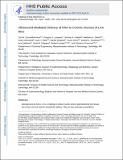| dc.contributor.author | Schoellhammer, Carl Magnus | |
| dc.contributor.author | Lauwers, Gregory Y. | |
| dc.contributor.author | Goettel, Jeremy A. | |
| dc.contributor.author | Oberli, Matthias | |
| dc.contributor.author | Cleveland, Cody | |
| dc.contributor.author | Park, June Y. | |
| dc.contributor.author | Minahan Jr, Daniel J | |
| dc.contributor.author | Chen, Yiyun | |
| dc.contributor.author | Anderson, Daniel Griffith | |
| dc.contributor.author | Jaklenec, Ana | |
| dc.contributor.author | Snapper, Scott B. | |
| dc.contributor.author | Langer, Robert S | |
| dc.contributor.author | Traverso, Giovanni | |
| dc.date.accessioned | 2019-08-09T17:38:12Z | |
| dc.date.available | 2019-08-09T17:38:12Z | |
| dc.date.issued | 2017-04 | |
| dc.date.submitted | 2017-01 | |
| dc.identifier.issn | 0016-5085 | |
| dc.identifier.uri | https://hdl.handle.net/1721.1/121977 | |
| dc.description.abstract | Background & Aims It is a challenge to deliver nucleic acids to gastrointestinal (GI) tissues due to their size and need for intracellular delivery. They are also extremely susceptible to degradation by nucleases, which are ubiquitous in the GI tract. We investigated whether ultrasound, which can permeabilize tissue through a phenomenon known as transient cavitation, can be used to deliver RNA to the colonic mucosa of living mice. Methods We investigated delivery of fluorescently labeled permeants to colon tissues of Yorkshire pigs ex vivo and mice in vivo. Colon tissues were collected and fluorescence was measured by confocal microscopy. We then evaluated whether ultrasound is effective in delivering small interfering (si)RNA to C57BL/6 mice with dextran sodium sulfate−induced colitis. Some mice were given siRNA against tumor necrosis factor (Tnf) mRNA for 6 days; colon tissues were collected and analyzed histologically and TNF protein levels measured by enzyme-linked immunosorbent assay. Feces were collected and assessed for consistency and occult bleeding. We delivered mRNA encoding firefly luciferase to colons of healthy C57BL/6 mice. Results Exposure of ex vivo pig colon tissues to 20 kHz ultrasound for 1 minute increased the level of delivery of 3 kDa dextran 7-fold compared with passive diffusion (P =.037); 40 kHz ultrasound application for 0.5 seconds increased the delivery 3.3-fold in living mice (P =.041). Confocal microscopy analyses of colon tissues from pigs revealed regions of punctuated fluorescent dextran signal, indicating intracellular delivery of macromolecules. In mice with colitis, ultrasound delivery of unencapsulated siRNA against Tnf mRNA reduced protein levels of TNF in colon tissues, compared with mice with colitis given siRNA against Tnf mRNA without ultrasound (P ≤.014), and reduced features of inflammation (P ≤ 4.1 × 10−5). Separately, colons of mice administered an mRNA encoding firefly luciferase with ultrasound and the D-luciferin substrate had levels of bioluminescence 11-fold greater than colons of mice given the mRNA alone (P =.0025). Ultrasound exposures of 40 kHz ultrasound for 0.5 seconds were well tolerated, even in mice with acute colitis. Conclusions Ultrasound can be used to deliver mRNAs and siRNAs to the colonic mucosa of mice and knock down expression of target mRNAs. Keywords: Antisense Therapy; Ulcerative Colitis; Inflammatory Bowel Disease; Ultrasound-Mediated Gastrointestinal Drug Delivery | en_US |
| dc.description.sponsorship | National Institutes of Health (U.S.) (Grant EB-000244) | en_US |
| dc.language.iso | en | |
| dc.publisher | Elsevier BV | en_US |
| dc.relation.isversionof | http://dx.doi.org/10.1053/j.gastro.2017.01.002 | en_US |
| dc.rights | Creative Commons Attribution-NonCommercial-NoDerivs License | en_US |
| dc.rights.uri | http://creativecommons.org/licenses/by-nc-nd/4.0/ | en_US |
| dc.source | PMC | en_US |
| dc.title | Ultrasound-Mediated Delivery of RNA to Colonic Mucosa of Live Mice | en_US |
| dc.type | Article | en_US |
| dc.identifier.citation | Schoellhammer, Carl M. et al. "Ultrasound-Mediated Delivery of RNA to Colonic Mucosa of Live Mice." Gastroenterology 152, 5 (April 2017): 1151–1160 © 2017 AGA Institute | en_US |
| dc.contributor.department | Massachusetts Institute of Technology. Department of Chemical Engineering | en_US |
| dc.contributor.department | Massachusetts Institute of Technology. Institute for Medical Engineering & Science | en_US |
| dc.contributor.department | Massachusetts Institute of Technology. Department of Materials Science and Engineering | en_US |
| dc.contributor.department | Massachusetts Institute of Technology. Department of Biological Engineering | en_US |
| dc.contributor.department | Koch Institute for Integrative Cancer Research at MIT | en_US |
| dc.relation.journal | Gastroenterology | en_US |
| dc.eprint.version | Author's final manuscript | en_US |
| dc.type.uri | http://purl.org/eprint/type/JournalArticle | en_US |
| eprint.status | http://purl.org/eprint/status/PeerReviewed | en_US |
| dc.date.updated | 2019-08-09T13:48:08Z | |
| dspace.date.submission | 2019-08-09T13:48:10Z | |
| mit.journal.volume | 152 | en_US |
| mit.journal.issue | 5 | en_US |
